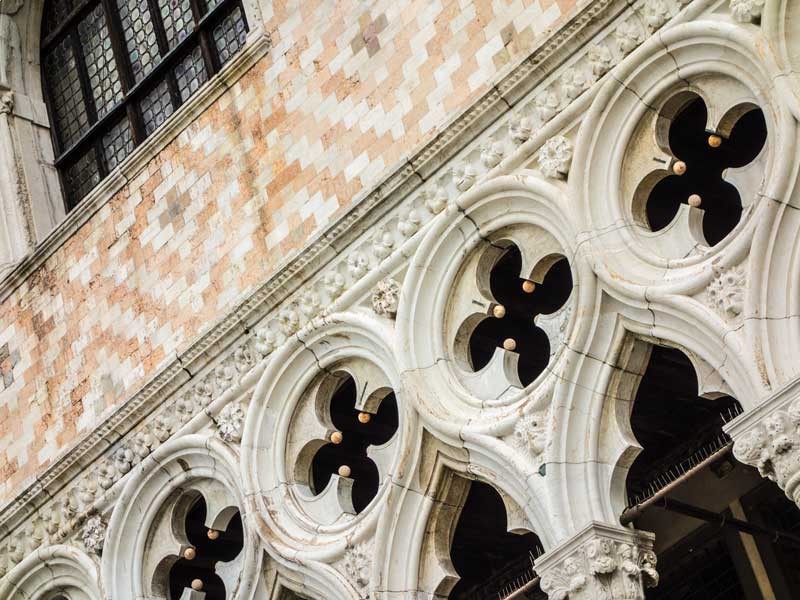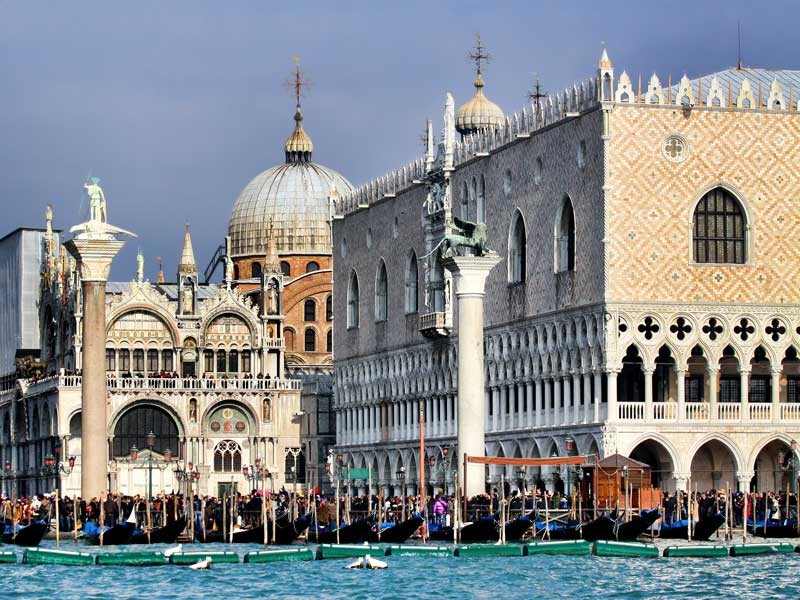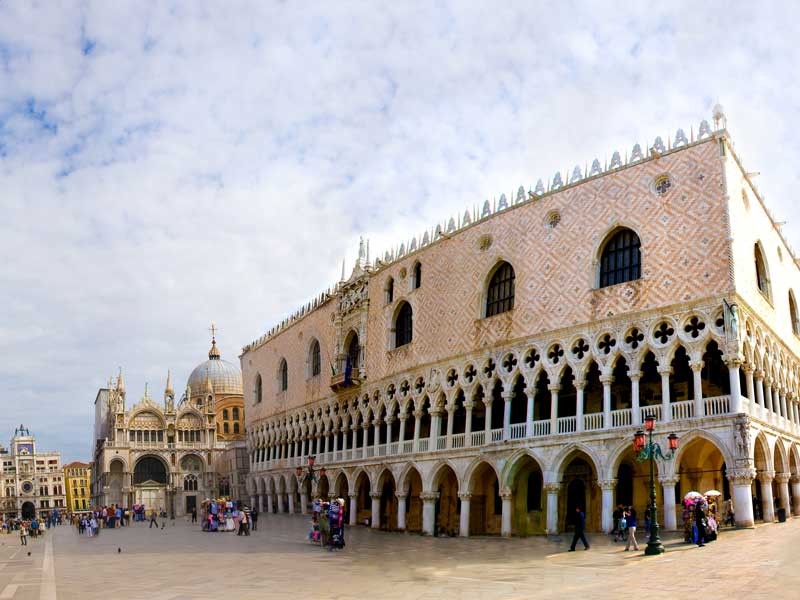Not accessible with the standard ticket, these tours take the visitor into the most secret and fascinating rooms in the Palace. The ticket includes the guided tour to the itineraries and also access (without a guide) to the rest of the Doge's Palace
Info & Booking
Ticket must be picked up at Doge's Palace
This reservation is made through an agency authorized by the official licensee of Venice Museums.
Reservations must be made with a minimum of 1 day notice.
Save time in ordering! Add into your basket all the museum tickets you want, then fill the form and send the request.
Before making your reservation, please, read the Ordering Informations
IMPORTANT NOTICE: After succesfully completing a reservation, you will receive two e- mails: the copy of your order (immediately after submitting your order) and the confirmation mail (one working day after). In order to receive them, please make sure you insert your e-mail address correctly and check that your anti-spam filter or antivirus are not blocking mails from our address [email protected]. Special attention for AOL mailbox users.
PLEASE NOTICE: Confirmed time is not always the same time you requested; museum automatically confirms the closest available time on the same date if requested time is sold out. Tickets will be confirmed upon availability of museum.
Tours are all with a specialised guide, for a minimum of 2 people and a maximum of 25; they start at fixed times according to the following schedule:
Italian 9.30; 11.10
English: 9.55 10.45; 11.35
French 10.20; 12.00
Visit at 10:45 is not available on August.
The tour is about 1 hour and 15 minutes long.
The ticket includes the guided tour to the itineraries and also access (without a guide) to the Doge's Palace.
Accessibility: The Secret Itineraries, the Prisons and Armoury are not wheelchair-accessible. They are also not suitable for pregnant women. All visitors must be over 6 years.
NOTE: The visit is confirmed 120 days before the date, so reservation guarantees the inclusion on the waiting list and delivery of the voucher as soon as we receive it from the Tower management. Charge to credit card made â??â??the business day following the request.
New Route starting July 22, 2013
The new route of the Secret Itineraries Tour starts with giving you direct access from the large and bright courtyard of the Doge's Palace through a narrow door into the small and damp cells of the "Pozzi,” the bleak and inhospitable prison cells in the basement of the prison building - and from there to the rest of a fascinating series of rooms and halls.
Cancellation Policy:
For cancellations once a confirmation code has been assigned to the reservation, up to 5 days after the confirmation, we can refund cost of unused tickets minus service fee (reservation fee and online booking fee). For further cancellations and no shows, no refund is possible.
Prices
Full price
Reduced price:
Children (E.U. and non E.U.) ages 6 to 14;
Escorts (max. 2) for groups of children
Students (E.U. and non E.U.) ages 15 to 29 (with valid student ID)
Escorts (max. 2) for groups of children or students
E.U. and non E.U. citizens over 65
Staff of the Ministero per i Beni e le Attività Culturali
Holders of the Rolling Venice Card
Holders of the Venice Card Orange
Residents of Venice
ICOM members
Holders of the combined ticket to the Museums of St. Mark’s Square
Holders of the Museum Pass issued by the Musei Civici Veneziani
Before You Book
PLEASE NOTE: Immediately after submitting an order, you will receive two email. The first email contains your order summary (this one you receive immediately after placing your order), the second email confirms your successful payment (one business day after placing the order). In order to receive these two emails, please make sure that you enter your email address correctly and check that antispam or antivirus filters do not block emails from our [email protected] address. Users of AOL, Comcast and Sbcglobal.net need to pay special attention to this, please. Vouchers will also be available, one business day after the request, at your dashboard.
IMPORTANT NOTE: The time you select on the order form is your preferred time. The closest available time, which can be anytime during opening hours on the selected date, will be automatically confirmed if your preferred time is no longer available.
Intro
So popular that entrances are restricted, and not accessible with the standard ticket, this tour takes you into the mysterious heart of Venice's most visited attraction: the Doge's Palace. The ticket includes the guided Secret Itineraries Tour and access (without a guide) to the rest of the Doge's Palace.
Doge's Palace - Secret Itineraries
From this room stairs lead to the beautiful Cancelleria Segreta. With all walls covered by cabinets, this room held the public deeds and secret contracts of most Venice magistratures. The high doors are covered with mirrors and decorated with coats of arms and the names of chancellors starting from 1268.
From here, the visit leads into the Piombi zone. The name comes from the lead covering of the roof. Here, some cells were set up for prisoners of the Consiglio dei Dieci (Council of Ten). These prisoners were imprisoned mostly for political reasons and short sentences, and were not usually held for serious crimes or while awaiting trial. The six or seven cells of the Piombi were set up with wood partitions that were nailed into the floor and reinforced with large iron sheets.
Giacomo Casanova, one of the famous prisoners of the palace, described the Piombi as offering much better conditions than the Pozzi, the terrible cells located in the ground floor. The two cells that once hosted Casanova have been reconstructed and are now part of the visit.
From the Piombi, you can visit the sottotetto ("under the roof," or attic), which is located at the Ponte della Paglia bridge, at the corner between the Bacino di San Marco and the Rio di Palazzo. In ancient times one of the towers of the old castle of the Doge was located here. Weapons from mostly the 14th century are exhibited in the cabinets.
The visit leads from the sottotetto down two stairs to the Sala degli Inquisitori - the Room of the Inquisition. This group of three magistrates, named Inquisitori alla Propagazione dei Segreti dello Stato, was created in 1539 to protect the acts of the State. Besides the absolute secrecy of their activities and the facts they discovered, the members of this frightful magistrature were supposed to guarantee objectivity, competence and efficiency. They could use any method for their investigations, even torture. The artist Tintoretto (1566-1567) decorated the ceiling.
The next room is the Sala dei Tre Capi. The Tre Capi were magistrates elected each month from among the ten members of the Council of the Ten (Consiglio dei Dieci). They were in charge of preparing the trials and implementing the Council resolutions. Giambattista Zelotti decorated the ceiling between 1553 and 1554, while the side sections are due to Veronese and Giambattista Ponchino.
For those who do not participate in the “Secret Itineraries” guided tour, the visit of the Doge's Palace begins by entering the palace complex through the Porta del Frumento into the courtyard surrounded by the four wings. The small marble facade with the clock dates back to 1615. Two bronze wells from the middle of the 16th century are located in the center of the courtyard. The two oldest wings of the Doge's Palace present simple facades. The Renaissance wing shows rich decorations, including the Giant's Stairway, with the impressive statues of Mars and Neptune (sculpted by Sansovino in 1565), symbolizing the power of Venice on land and sea.
The staircase, conceived by Antonio Rizzo, is next to the arch built in the period of Doge Francesco Foscari. It is faced with Istria stone and red marble from Verona. The staircase leads to the Porta della Carta through the Foscari entrance hall, which is nowadays the visitors’ exit from the Doge's Palace. To the right of the stairway is the Cortile dei Senatori (16th century), where the senators would wait before government meetings. On the other side of this same wing the majestic Scala dei Censori (Censor's Staircase) leads to the upper floors of the Doge's Palace.
The Museo dell'Opera hosts ancient architectural pieces of the Doge's Palace, including the capitals that were substituted by copies in an important restoration effort in 1875. These precious sculptures decorated the medieval facades of the Doge's Palace with allegoric, religious, moral, and political statements.
The first floor, called Piano delle Logge, includes entrances to the east, south, and west wings. From here, you can enjoy splendid views of the courtyard and the Piazzetta San Marco. This floor hosts the offices of the Soprintendenza per i Beni Ambientali e Architettonici di Venezia and some offices of the direction of the Venice Civic Museums.
From here, your Doge's Palace visit proceeds to the Scala d'Oro (Golden Staircase) through the Renaissance wing. This wing hosted the offices of many magistrates. You will see some lions' mouths on the wall: citizens could place crime or embezzlement accusations into these. The messages would fall into a wooden box opened by the office to which they were addressed.
On this same wall you will also see two plaques. The first dates from the papacy of Urban V during the 1300s: It promises indulgences to whoever showed charity to prisoners. The other was created by Alessandro Vittoria to celebrate the 1674 visit of Henry III of France to Venice. Marble sculptures by Tiziano Aspetti decorate the access to the Scala d'Oro: one represents Atlas holding the heavens, the other Hercules killing the many-headed Hydra.
The apartments of the Doge are located in the palace area between the Rio della Canonica (the aquatic entrance to the Doge’s Palace), the Scala d'Oro and the apse of the Basilica di San Marco. A small but prestigious residence formed the basic nucleus of the apartments, while the rooms closest to the Scala d'Oro had the function of bridging the private life of the doge with his public duties. The doge retired to the private residence for dinner and to pass time with the members of his family at the end of the day.
Between the Piano delle Logge and the second floor lies the Atrio Quadrato (Square Atrium). This atrium leads to the Stanze Istituzionali (Institutional Rooms), where the political and administrative life of the Republic was conducted. The main branches of government worked here: the Maggior Consiglio (Great Council), the Senato (Senate), the Collegio (Cabinet), and the most important justice magistrates, from the Consiglio dei Dieci (Council of the Ten) to the Quarantie (Appeal Court). In all the rooms, the decorations celebrate the virtue of the State and its functions.
The Doge's Palace, seat of all government institutions of the Republic, included the justice department and the prisons. During the second half of the 1500s a new building was constructed on the other side of the river entirely dedicated to prison functions. The construction of these “New Prisons” had the purpose of improving the living conditions of the prisoners.
Following tradition, the walls, roof, and ceiling of each cell were coated with crossed larch wood layers. These New Prisons are one of the first examples of construction solely dedicated for use as a state prison.
Your itinerary then takes you to the two lower floors and the prison courtyard, where you will also see the ceramic collection found during the archaeological excavations in the area. Your visit then continues to the Ponte dei Sospiri and the Sala dei Censori.
The Ponte dei Sospiri (Bridge of Sighs) was created in 1614 to connect the Doge's Palace to the New Prisons building. Two corridors separated by a wall form this famous closed and covered bridge. One corridor links the prisons to the Sale del Magistrato alle Leggi, the Sala della Quarantia Criminal, and to the noble floor of the palace. The other corridor joins the prisons to the Sale dell'Avogaria and the Parlatorio. Both corridors are connected to the stairs that lead from the Pozzi (the prisons below water level) to the Piombi (the prisons under the roof). The famous name of the Ponte dei Sospiri comes from the romantic era: leaving the tribunal of the Doge's Palace, the prisoners crossed the bridge to serve their sentence, sighing heavily as they caught a glimpse of freedom through the small windows.
The rooms of the Armeria host the museum of arms and ammunitions. Its nucleus dates back to the 16th century. During the Venetian Republic, the Armeria was under the protection of the Counsel of the Ten. It contained war instruments ready for use by the squires of the Doge's Palace, and the highly qualified and organized Arsenalotti guards. Partially lost after the end of the Republic, the arms collection has today more than two thousand pieces.
Cancellation Policy
Once a confirmation code has been assigned to the reservation we can refund the cost of unused tickets minus a service fee (reservation fee and online booking fee) up to 5 days after the confirmation is sent. No refund is possible for or cancellations for later cancellations, and for no shows.
Tickets
Full price
Reduced price:
Children (E.U. and non E.U.) ages 6 to 14;
Escorts (max. 2) for groups of children
Students (E.U. and non E.U.) ages 15 to 29 (with valid student ID)
Escorts (max. 2) for groups of children or students
E.U. and non E.U. citizens over 65
Staff of the Ministero per i Beni e le Attività Culturali
Holders of the Rolling Venice Card
Holders of the Venice Card Orange
Residents of Venice
ICOM members
Holders of the combined ticket to the Museums of St. Mark’s Square
Holders of the Museum Pass issued by the Musei Civici Veneziani



